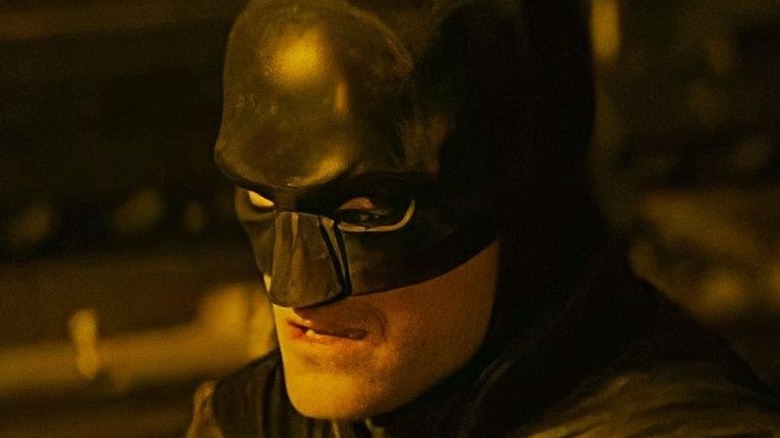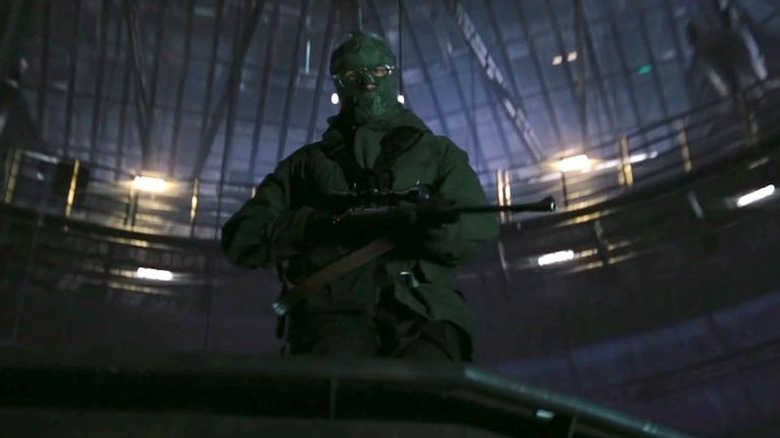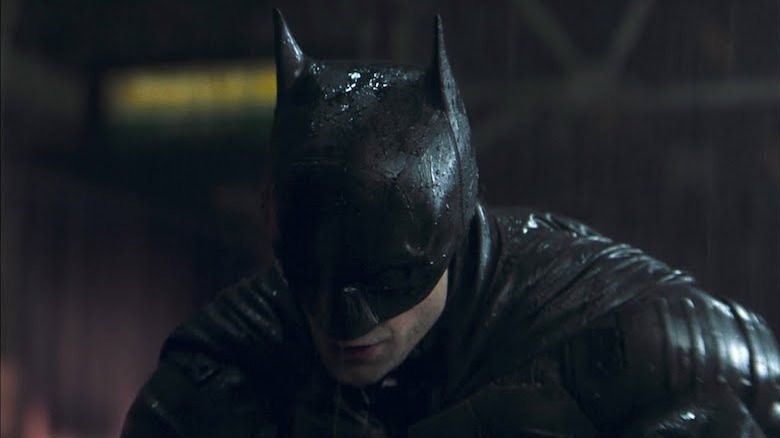It's Time To Talk About That Fight Scene In The Batman
Contains spoilers for "The Batman."
Director Matt Reeves ditches a traditional origin story for his latest movie, "The Batman." Instead, the 2022 film begins with Bruce Wayne (Robert Pattinson) well into his second year of vigilante work in Gotham City. He's a brutal force on the streets as he breezes through fights with thugs and seasoned gangsters alike to protect the innocent — although he's definitely still a little rough around the edges. Regular citizens aren't sure whether the Dark Knight is a hero or a monster, and he still has an incredibly uneasy relationship with the Gotham City Police Department despite the unquestioning trust Jim Gordon (Jeffrey Wright) places in him.
Things in Gotham go from bad to worse when the Riddler (Paul Dano) rears his ugly, mask-covered mug to target institutional corruption in Gotham. He starts with the mayor (Rupert Penry-Jones). From there, Batman and Selina Kyle, aka Catwoman (Zoë Kravitz), try to figure out why the Riddler is hell-bent on tearing the city down. Unfortunately, that isn't so easy when the killer's mysterious game is built upon riddles, mind-bending mysteries, and a criminal conspiracy.
The early reception to the movie has been incredibly positive, and it currently has an 86% critic score on Rotten Tomatoes, with WhatToWatch saying it "fires on all cylinders." But, like every good comic book movie, "The Batman" ends with a dramatic fight to save the day. It's time to look at the hero's tactics in the Gotham Arena brawl.
Does Batman break his one rule?
The Riddler's plan to destroy Gotham's infrastructure culminates with the detonation of seven bombs around the city's sea wall, flooding the downtown area. Thousands of Gotham citizens congregating downtown to celebrate Bella Real's (Jayme Lawson) mayoral win rush to the Gotham Arena to escape the high waters. As they seek safety, a gang of Riddler's followers, all dressed in matching uniforms, open fire from rigging high above the arena. Thankfully, Batman and Catwoman are on the scene to take them down and save the people down below, but the Caped Crusader might have broken his rule against killing in the midst of fighting back.
Historically, whether it's in film, TV, comics, or video games, Batman always makes a point that he doesn't kill criminals. This rule stems from the trauma of watching his parents die that night in Crime Alley. However, during "The Batman" finale, as the gunmen working for Riddler take shots at Batman at close range, he deflects the bullets back at the shooters, which sends a few of them slumping to the floor. It's not clear if their wounds are fatal, but it doesn't exactly look good.
Obviously, there's the suspension of disbelief here. The audience doesn't see Batman kill anyone, nor do we see the Riddler's gunmen die in the fight. Even the lone goon he nearly beats to a pulp is saved when Jim Gordon intervenes. As such, it's easy to assume that Batman stuck to his one rule. But, in this grim and gritty world that Matt Reeves has created, it wouldn't be a stretch to think that if they died because of the fight, Batman wouldn't be too bothered by it. Because the film ends on a surprisingly hopeful note, maybe the Bat will have a different outlook when it comes to brutalizing his foes from now on.
Should Batman's 'no killing' rule matter?
In the last decade or so, the debate over whether Batman inadvertently kills people has become a hot-button topic (via IGN) — even hitting a fever pitch with the Dark Knight's actions in "Batman v Superman: Dawn of Justice." Zack Snyder's second movie in the DC Extended Universe sees Ben Affleck's hero dish out some brutal punishment to Lex Luthor's (Jesse Eisenberg) goons across the film. Whether it's his chaotic car chase through Gotham Harbor or that savage warehouse fight, the older version of the Dark Knight doesn't pull his punches at all. Realistically, it's all about the story that Batman happens to be in at the time. The "no killing" rule can be pushed or broken depending on which director or author is controlling Batman's story.
With the Robert Pattinson-led "The Batman," it's clear that this version of the hero is still questioning his approach to fighting crime; even he acknowledges he needs to be a better symbol to the people of Gotham. So, although he's not too bothered by deflecting bullets back at his foes, he is at least trying to be better. Obviously, there's an argument to be made that Bruce Wayne isn't actively trying to kill the Riddler's followers while in Batman mode; he's just defending himself.
In the most idealized versions of the character, like "Batman: The Animated Series," the specifics about his "no killing" rule definitely matter. But when the story is directly analyzing who Batman is and how he's growing as a hero, there's a little bit of breathing room when it comes to his violent streak.


